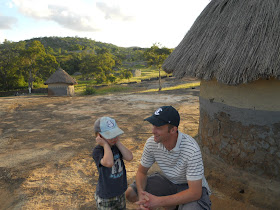Though it wasn't intended, our recent trip throughout the land of Zim proved to be a lesson all about nature's relationship with the rawest, most beautiful continent in the world...

Though it wasn't intended, our recent trip throughout the land of Zim proved to be a lesson all about nature's relationship with the rawest, most beautiful continent in the world... Everywhere we went, starting on that first day in Masvingo, we found ourselves struggling with the awe of our tiny lives amid such a monumental setting that had seen millions go before us.
Growing up in Iowa my concept of history as a child spanned approximately 150 years. My surroundings were mostly new, and certainly felt less than historical. When I moved to London and New York City, my sense of history and my physical placement among significant locations grew to -gasp- almost five or six hundred years. I found myself eating lunch among colonial gravesites that had watched as the cities grew around them. And it blew me away. And changed where I stood in creation.
Then came Africa.
History here
seems not measured in just years or centuries, but feels somehow connected to
the very first days of the earth. Primal and primitive, my Africa stands
touched and untouched as a reminder of the earth that exists as a witness of a fleeting human race. The hills and mountains that look over Great Zimbabwe's empty shoulders are a powerful reminder of ancient times that have come and gone over and over.
Below is a quick introduction to a haunting World Heritage site that readied me for the many days of ancient Africa that soon followed:
Great Zimbabwe's most prominent feature, its mortarless walls, were
constructed mostly of carved soapstone starting in the 11 century, and
served as a royal palace for the monarch of the Kingdom of Zimbabwe for
hundreds of years. Unique artifacts and sculptures have been found throughout the ruins. Many of these have been recently returned to Great Zimbabwe's living room sized museum from foreign countries that removed and preserved these pieces in their own museums worldwide. The ruins are categorized into three parts: the Hill Complex, Valley Complex, and the Great Enclosure.
Great Zimbabwe's Great Enclosure is the most famous structure; at 36 feet high (11 m) it extends approximately
820 feet (250 m). It stands as the largest ancient structure south of the
Sahara Desert. Here Jonas, friend Abbie, and Alios stand in the middle of the queen's quarters.
The ruins together span 1,800 surrounding acres and at one time housed over 18,000 inhabitants.
The walls feel both oddly empty and full of life at the same time; hundreds of vervet monkeys now call this city of ruins home. Jonas was tickled.
Alios and Kurt, with Jonas running ahead
The chevron design (along the top of the wall) is a pattern that originates here but is mimicked all over the country.

The crazy flora surrounding the ruins made me feel like I was in Peter Jackson's King Kong.
A sample Shona village below the ruins preserves some of the ancient culture. (I love that this dancer has a cell phone in her hand.)









